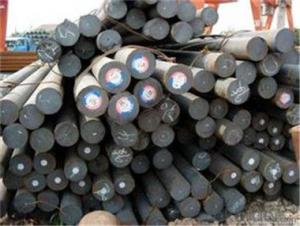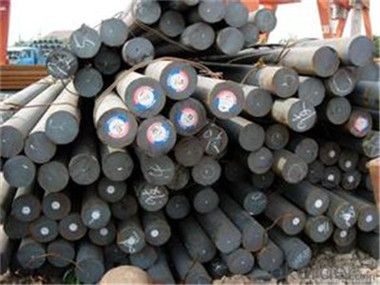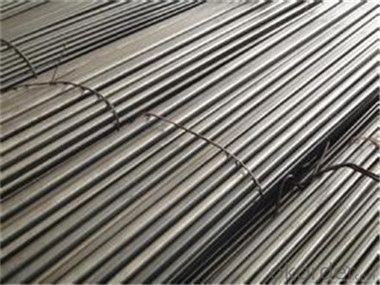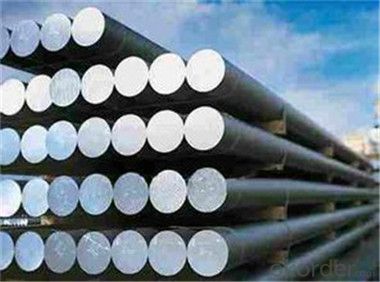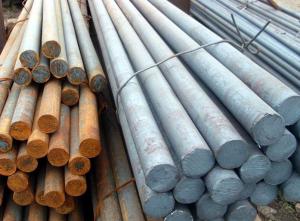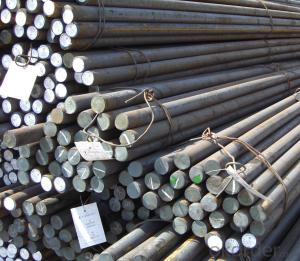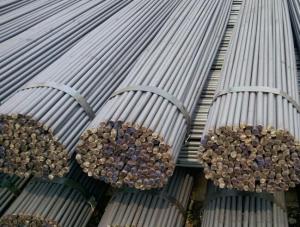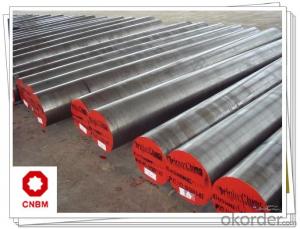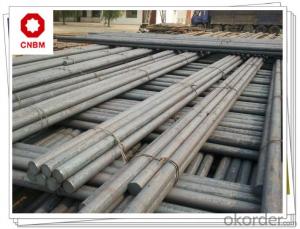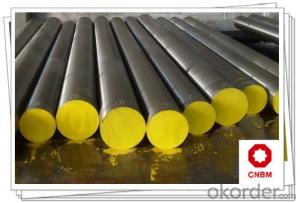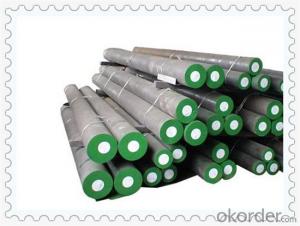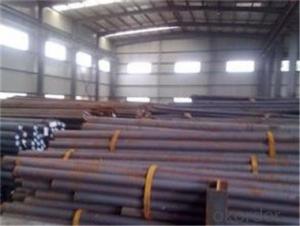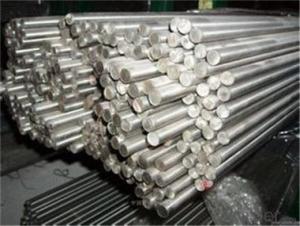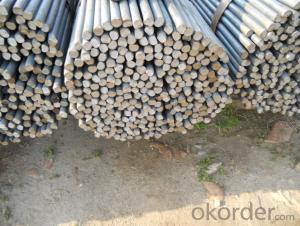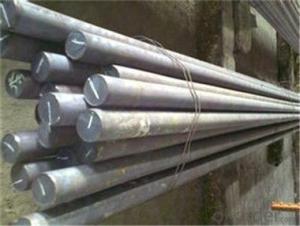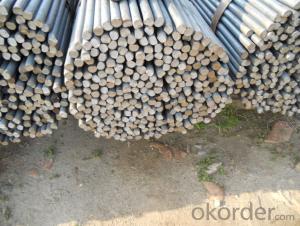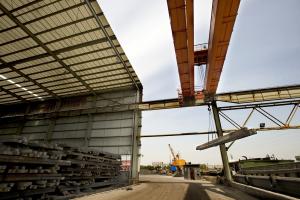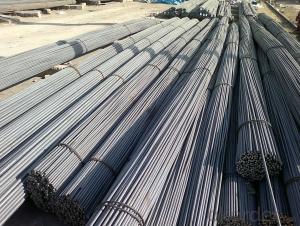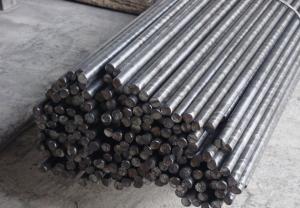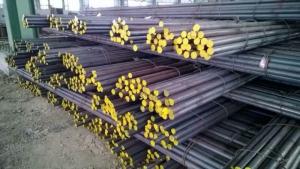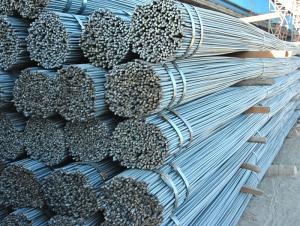High Quality Cheaper SAE1018 Steel Round Bar in China
- Loading Port:
- Tianjin
- Payment Terms:
- TT OR LC
- Min Order Qty:
- 77 m.t.
- Supply Capability:
- 20000333 m.t./month
OKorder Service Pledge
OKorder Financial Service
You Might Also Like
Description of steel round bar:
Mild steel is sometimes referred to as carbon steel or plain steel. Typically, it is stiff and strong. Carbon steelsdo rust easily, but they can be easily painted or primed. They are cheap so they are the normal choice for most fabrications. Mild Steel can be easily cut or drilled to meet your requests.It is used in the manufacture of a higher strength and higher quenching and tempering section.
Festures of steel round bar:
1.Dia 80-800mm Length:2000-13000mm or as required
2.Technique:Forged
3.Delivery Time:45 days
Specifications of steel round bar:
Grade | Chemical Contents % | ||||
C | Si | Mn | P | S | |
45 | 0.42~0.50 | 0.17~0.37 | 0.50~0.80 | ≤0.035 | ≤0.035 |
50 | 0.47~0.55 | 0.17~0.37 | 0.50~0.80 | ≤0.035 | ≤0.035 |
55 | 0.52~0.60 | 0.17~0.37 | 0.50~0.80 | ≤0.035 | |
Images of steel round bar:
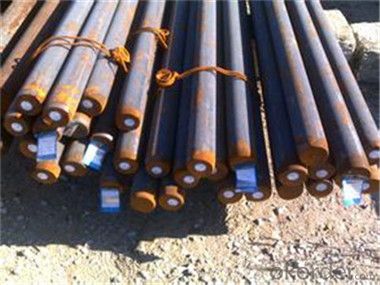
FAQ:
1. What is your package?
Packing situation: standard seaworthy packing or as customer required.
2. How long is the lead time?
Delivery time: 45 days after order confirmed.
3. What payment term do you accept?
Payment: T/T or L/C at sight.
- Q: What are the advantages of using nickel-chromium-molybdenum alloy steel round bars?
- The advantages of using nickel-chromium-molybdenum alloy steel round bars include high strength, excellent corrosion resistance, good toughness, and superior heat resistance. These properties make the alloy steel bars ideal for applications in industries such as aerospace, oil and gas, and chemical processing, where durability and reliability are crucial. Additionally, the alloy's resistance to oxidation and high-temperature environments makes it suitable for use in high-stress applications, such as turbine engine components and pressure vessels.
- Q: Can steel round bars be used in the chemical industry?
- Yes, steel round bars can be used in the chemical industry. Steel is a versatile material with excellent mechanical properties and corrosion resistance, making it suitable for various applications in the chemical industry. Steel round bars are commonly used for manufacturing equipment, such as reactors, tanks, and piping systems, where strength, durability, and resistance to chemical substances are important factors.
- Q: How do you calculate the deflection of a steel round bar?
- To calculate the deflection of a steel round bar, you need to consider various factors such as the bar's length, diameter, and the applied load. The deflection of a bar refers to the amount it bends or flexes under a specific load. The deflection can be determined using the formula for beam deflection, which is derived from Euler-Bernoulli beam theory. The formula is as follows: δ = (F * L^3) / (48 * E * I) Where: - δ represents deflection - F is the applied load - L is the length of the bar - E is the modulus of elasticity of the steel material - I is the moment of inertia of the round bar To calculate the moment of inertia (I) for a round bar, you can use the formula: I = (π * D^4) / 64 Where: - I is the moment of inertia - D is the diameter of the round bar By substituting the values into the formula, you can calculate the deflection of the steel round bar under the given load. It is important to note that these calculations assume the bar is perfectly elastic and obeys the principles of linear elasticity.
- Q: Can steel round bars be used in the production of medical equipment?
- Medical equipment can indeed utilize steel round bars. This is because steel is a widely employed material in the production of medical devices and equipment. Its strength, durability, and versatility make it a popular choice. By utilizing steel round bars, one can fashion various components of medical equipment, including surgical instruments, orthopedic implants, diagnostic tools, and hospital furniture. Steel possesses desirable properties, such as resistance to corrosion and the ability to be sterilized, rendering it suitable for use in the medical sector where hygiene and patient safety are paramount. Furthermore, steel round bars can be easily machined and fabricated into different shapes and sizes, allowing for the customization of medical equipment to fulfill specific requirements.
- Q: Can steel round bars be machined or forged?
- Steel round bars can indeed be machined or forged. Machining involves the utilization of cutting tools to extract material from the round bar, achieving the desired shape or dimension. This can be accomplished through a variety of methods, including turning, milling, drilling, or grinding. Machining is frequently employed in the creation of precise components or parts. On the flip side, forging entails heating the steel round bar and shaping it by applying compressive forces. This is typically accomplished using a hammer or press, deforming the material and creating the desired shape. Forging aids in the enhancement of the steel's mechanical properties, such as strength and toughness, by aligning the grain structure and eliminating any internal flaws. Both machining and forging techniques can be utilized to shape and manipulate steel round bars to meet specific requirements for various applications in industries like automotive, construction, energy, and manufacturing. The decision to employ machining or forging is contingent upon factors such as the complexity of the part, required tolerances, material properties, and the desired final product.
- Q: What are the different grades of steel used in round bars?
- Round bars are made from various grades of steel, each possessing its own distinct properties and applications. Some commonly utilized grades are as follows: 1. Grade 1018 - Mild Steel: This steel has low carbon content, enabling easy machinability and weldability. It finds extensive use in general engineering fields, such as construction, automotive, and machinery. 2. Grade 1045 - Carbon Steel: Known for its medium carbon composition, this steel exhibits high tensile strength and excellent wear resistance. It is commonly employed in applications involving shafts, axles, gears, and other high-stress components. 3. Grades 4140 and 4340 - Alloy Steel: Alloy steels incorporate additional elements like chromium, molybdenum, or nickel to enhance their mechanical properties. These grades offer exceptional strength, toughness, and wear resistance. They are frequently employed in applications that demand high durability and strength, such as automotive parts, aircraft components, and industrial machinery. 4. Grades 304 and 316 - Stainless Steel: Stainless steel is a corrosion-resistant alloy containing a minimum of 10.5% chromium. It finds wide usage in industries such as food processing, chemicals, and medicine due to its remarkable resistance to corrosion, heat, and its appealing aesthetic. 5. Grades A2 and D2 - Tool Steel: Tool steels are designed specifically to possess high hardness, wear resistance, and toughness. They are commonly employed in the manufacture of cutting tools, dies, and molds. These examples represent just a fraction of the diverse range of steel grades used in round bars. The selection of the appropriate grade depends on specific requirements for the application, including strength, corrosion resistance, heat resistance, and machinability.
- Q: What are the different methods used for machining steel round bars?
- There are several methods used for machining steel round bars, including turning, milling, drilling, and grinding. Turning involves rotating the bar against a cutting tool to create a desired shape. Milling utilizes rotary cutters to remove material from the bar's surface. Drilling involves creating holes in the bar using a drill bit. Grinding uses an abrasive wheel to smooth or shape the bar's surface. These methods may be used individually or in combination, depending on the desired outcome and the specific requirements of the project.
- Q: What are the advantages of using high-strength steel round bars?
- Using high-strength steel round bars in various applications brings several advantages. Firstly, these bars have an exceptional strength-to-weight ratio. Despite being lighter than other materials, they possess significantly higher strength. This advantage allows for the construction of sturdy and lightweight structures, making them ideal for weight reduction in industries like aerospace and automotive. Secondly, high-strength steel round bars offer excellent resistance to wear, fatigue, and impact. This makes them highly durable and able to withstand heavy loads and repeated stress, enhancing the lifespan and performance of structures or components. This is particularly beneficial in construction, where materials must maintain structural integrity over time. Furthermore, high-strength steel round bars provide improved design flexibility due to their versatility. They can be easily shaped, machined, and welded, allowing for the creation of complex and customized structures or components. This enables engineers and designers to optimize their designs and achieve specific performance requirements. In addition, high-strength steel round bars offer enhanced resistance to corrosion, making them suitable for applications in harsh environmental conditions. By utilizing these bars, structures or components can maintain their integrity and functionality for extended periods, reducing the need for frequent maintenance and replacement. Finally, using high-strength steel round bars can lead to long-term cost savings. Despite their higher initial cost, their superior strength and durability significantly reduce maintenance, repair, and replacement costs over time. Additionally, their lightweight nature contributes to fuel efficiency, resulting in cost savings in transportation and other industries. Overall, the advantages of using high-strength steel round bars include a high strength-to-weight ratio, excellent resistance to wear and fatigue, improved design flexibility, enhanced corrosion resistance, and potential cost savings. These benefits make them a preferred choice for a wide range of applications.
- Q: Can steel round bars be used in the automotive industry?
- Yes, steel round bars can be used in the automotive industry. Steel round bars are commonly used in the automotive industry for various applications. They are often utilized for manufacturing components such as axles, drive shafts, suspension parts, and steering components. Steel round bars offer high strength, durability, and resistance to wear and tear, making them suitable for withstanding the demanding conditions and loads experienced by automotive components. Additionally, steel round bars can be easily machined and welded, allowing for efficient production and assembly processes in the automotive industry. Overall, steel round bars are a reliable and cost-effective choice for automotive manufacturers, making them a popular material for use in the industry.
- Q: How do you prevent warping during welding of steel round bars?
- To prevent warping during welding of steel round bars, there are several precautions that can be taken: 1. Proper fit-up: Ensure that the round bars are properly aligned and fit together before welding. Any gaps or misalignments can lead to uneven heating and cooling, increasing the chances of warping. 2. Welding sequence: Divide the welding into multiple smaller sections or segments instead of welding continuously along the entire length of the round bar. This will help distribute the heat more evenly and reduce the risk of warping. 3. Welding technique: Use a welding technique that minimizes heat input, such as pulse welding or tack welding. These techniques allow for controlled and intermittent heating, which reduces the chances of warping. 4. Preheating: Preheating the round bars before welding can also help prevent warping. This is especially important for thicker bars or when welding dissimilar metals. Preheating helps to reduce the temperature gradient between the weld and the surrounding material, minimizing the risk of warping. 5. Heat control: Monitor and control the heat input during welding. Excessive heat can cause rapid expansion and contraction, leading to warping. Use appropriate welding parameters, such as lower amperage and shorter welding times, to control the heat input. 6. Welding fixtures: Use welding fixtures or jigs to hold the round bars in place during welding. This helps to maintain proper alignment and prevents movement during the welding process, reducing the chances of warping. 7. Post-welding cooling: Allow the welded round bars to cool down slowly and naturally. Avoid rapid cooling methods like quenching, as they can induce stress and increase the risk of warping. By implementing these measures, the risk of warping during welding of steel round bars can be significantly reduced, resulting in better quality and more reliable welded joints.
Send your message to us
High Quality Cheaper SAE1018 Steel Round Bar in China
- Loading Port:
- Tianjin
- Payment Terms:
- TT OR LC
- Min Order Qty:
- 77 m.t.
- Supply Capability:
- 20000333 m.t./month
OKorder Service Pledge
OKorder Financial Service
Similar products
Hot products
Hot Searches
